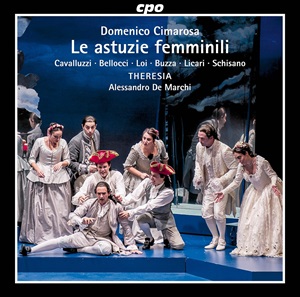
Domenico Cimarosa (1749-1801)
Le astuzie femminili (1794)
Bellina: Eleonora Bellocci (soprano)
Ersilia: Martina Licari (soprano)
Don Gianpaolo Lasagna: Rocco Cavalluzzi (bass)
Don Romualdo: Matteo Loi (baritone)
Filandro: Valentino Buzza (tenor)
Leonora: Angela Schisano (alto)
Theresia / Alessandro De Marchi
rec. 2022, Teatro Comunale Flavio Vespasiano, Rieti, Italy
Booklet with Italian libretto and English translation, commentary in German, English, and Italian included
cpo 555 595-2 [2 CDs: 159]
Premiered on 26 August 1794 in the Teatro dei Fiorentini in Naples, Domenico Cimarosa’s two-act ‘Commedia per musica’ Le astuzie femminili enjoyed success from its initial audience. It was performed in Rome, Florence, Barcelona, Berlin, Venice, and other European cities within the composer’s lifetime. Le astuzie femminili did not fall into oblivion after its initial run of performances, but remained known to connoisseurs of opéra bouffe. The opera was revived in many locations during the 1870s, including Naples, Bologna, Florence, London, Paris, and Rome.
Giuseppe Palomba based the libretto for Le astuzie femminili on Giovanni Bertati’s text for Cimarosa’s one-act opera Amor rende sagace, which received its premiere at the Burgtheater in Vienna on 1 April 1793. The plot begins with the will of Bellina’s father, who makes her his universal heir if she marries Don Giampaolo Lasagna. Bellina’s guardian, Don Romualdo, also covets her as a bride, but she outwits him and Giampaolo to marry Filandro, the man she loves. Bellina and Filandro’s duets express intimacy, while Giampaolo’s aria (‘Le figliuole, che sò de vent’anne’) near the end of the opera conveys acceptance that he will not marry Bellina. Love, thus, triumphs over legal arrangements. Cimarosa crafted masterful arias, ensembles, and finales, the second of which ends with a Russian dance, a reminiscence of St. Petersburg, where Cimarosa was employed at the court of Catherine the Great (1787-91). The work reflects Neapolitan opera buffa, including the local dialect, comic duels, and picturesque disguises.
Although the present recording is the first complete one of this work, there have been occasional revivals. An arrangement by Ottorino Respighi, for example, was performed at the Opéra in Paris (1920). Previous recordings include a 1959 RAI broadcast under Mario Rossi’s direction, featuring Graziella Sciutti, Luigi Alva, and Sesto Bruscantini. The Piccola Scala in Milan staged the work in Franco Zeffirelli’s production (1960), and Luca Ronconi directed it at the Teatro Mediterraneo in Naples (1974). These performances were adaptations, whereas Alessandro De Marchi conducts the unabridged original score with a period-instrument ensemble, Theresia.
Theresia’s playing is brilliant and electrifying under De Marchi’s dynamic, propulsive direction. In the role of Bellina (Dottor Romualdo’s pupil), the soprano Eleonora Bellocci’s range of expressions (e.g., affectionate, pert, and sly) underline how the character masters every situation in which she appears. As Bellina’s beloved Filandro, Valentino Buzza has a lyric tenor voice with virtuosic high notes and requisite warmth in tender moments. The alto Angela Schisano portrays Leonora (Romualdo’s housekeeper) as witty and sympathetic. The bass Rocco Cavalluzzi (Don Giampaolo) and the baritone Matteo Loi (Don Romualdo) sound young, which serves as a reminder that ‘mature’ characters in eighteenth-century theatre were often in their late twenties and early thirties. Martina Licori’s light soprano distinguishes Ersilia from her friend, Bellina.
A contemporary to Wolfgang Amadeus Mozart, Cimarosa prefigured Gioachino Rossini’s comic masterpieces. The present recording of Le astuzie femminili is an attractive complement to Il matrimonio segreto (1792) by the same conductor and on the same label, which I reviewed in February 2022. The presentation by cpo is exemplary: the booklet contains the original libretto and an English translation thereof, as well as commentary about the opera’s genesis and performing history. This new recording enriches knowledge about Cimarosa, comic opera, and the musical landscape in which the Wiener Klassik existed.
This performance is also available on DVD and Blu-ray.
Daniel Floyd
Buying this recording via a link below generates revenue for MWI and helps us keep free access to the site




















